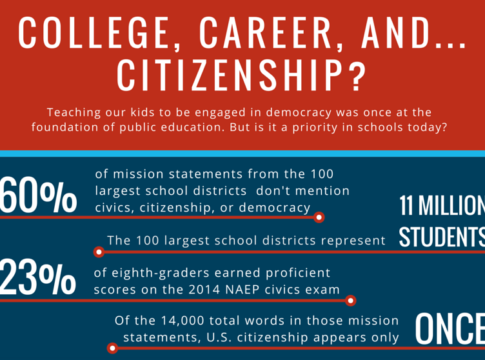It is hard to be a reporter in America for very long, including as one trying to fathom our richly diverse public education system, without having to deal with a Constitutional issue. And so I jumped at the offer last winter from my friend and former colleague at Life Magazine, Todd Brewster, to become a Jennings Fellow at the Peter Jennings Project for Journalists and the Constitution. (Todd worked with the ABC News anchor on several projects, including the big bestseller The Century.)
It was an intense weekend in Philadelphia rubbing elbows – and sharing bagels — with the likes of Ken Starr, Jeffrey Toobin, and Guido Calebresi, but I was surprised by the number of Constitutional questions arising these days in the public schools and was lucky enough to be in a workshop run by Vic Walczak, legal director for the ACLU in Pennsyslvania, a man who has had his share of education challenges lately.
In fact, while we were meeting in the National Constitution Center last February, Walczak had three different cases before the federal Third Circuit Court of Appeals just around the corner. One was about “sexting,” a phenomenon that I knew nothing about; the other two involved territorial issues and the question of where exactly school rights and responsibilities began and ended.
Most of the Jennings Fellows who were in the sexting session had not heard of Tunkhannock, PA (a former lumber town, population roughly 2000, in the northern part of the Keystone State) where the sexting students went to school. And some of us over the age of 30, still trying to understand what texting was all about, were not quite sure about sexting (though we were soon to learn that it is the practice of sending sexually explicit photographs by cell phone – and that lots of kids were doing it, including even in rural Pennsylvania).
So, as we learned, the day came when school officials in Tunkhannock learned that students were sending sexually explicit pictures – of other students — to each other by cell phone. And for reasons not clearly known to me, the school turned the matter over to the local district attorney, George Skumanick, Jr., who then decided, for reasons also unknown to this writer, to prosecute the kids; rather, he decided to threaten to prosecute.
Among the many thorny issues suddenly on the table was whether children could be prosecuted for distributing non-lewd, semi-naked photographs of themselves. Obviously, an adult could be charged for such an offense; after all, it was exploiting a minor. But could you be both a perpetrator and a victim in the same crime? In this case, two underage girls were posed from the waist up in their bras and a third girl was shown just emerging from the shower with a towel wrapped around her waist; the pictures were taken by the children and sent by them.
In fact, Miller v. Skumanick (eventually Miller v. Mitchell in the appeals court) got even more interesting because the prosecutor told the dozen students caught up in the affair, that he would not prosecute them if they accepted school suspension, submitted to drug tests, wrote an essay about their infractions, and attended a five-week re-education program in which they would admit that what they did was wrong and – for the girls — had learned what it meant to be a girl in today’s society.
This was where Vic Walczak entered the picture, so to speak.
What was the issue? That was the question Walczak posed to us during our Jennings seminar. Free speech, we all said. Double jeopardy, someone whispered.
Nope. Walczak explained that because the prosecutor was demanding that the students say certain things or get prosecuted, it was not a free speech case but one of “compelled speech.” (Having just finished a book about the Pledge of Allegiance, I am familiar with the Jehovah’s Witnesses successful defense of their children’s right not to be forced to say the Pledge at school, as determined in West Virginia Board of Education v. Barnette, but that was 1943.) Skumanick had not charged anyone with a criminal offense, but he was demanding that suspects say certain things –writing an essay and attending the re-education program – in order to avoid prosecution. Three students refused the offer and Walczak leapt in to petition the federal district court to grant a temporary restraining order stopping further prosecution.
In a March 2009 ruling, Judge James Munley wrote that while such an injunction is an “extraordinary remedy,” he would grant it because “the parents in this case have a Fourteenth Amendment substantive due process right ‘to be free from state interference with family relations.’” He also found that that defendants had made a strong case — would be “likely to succeed on the merits” — that “being compelled to describe their behavior as wrong on threat of a felony conviction forces them to express a belief they do not hold and thus violates their right to be free of compelled speech.” Munley also ruled that the “threat of prosecution has a chilling effect on plaintiffs expressing themselves by appearing in photographs, even such innocent photographs as those in bathing suits.”
In March of this year, shortly after the Peter Jennings Project conference, the Third Circuit Court of Appeals agreed, ruling that prosecution of the Tunkhannock teens was “in retaliation for [the plaintiffs’] exercise of her constitutional rights not to attend the education program,” effectively ending prosecution of the case before it began. Even though the Court did not reach – because it didn’t need to – the alluring question of whether a child sending a picture of him or herself can be child pornography, the victory was an important message to prosecutors that the Constitution sets limits on their authority to prosecute students for sexting.
The other two pending school-related cases that Walczak has overseen involve questions about the reach of school authority. In two separate incidents students – one in middle school and one in high school — created Internet websites mocking school principals. In both cases, the sites were created at home and during non-school hours. While the law regulating students’ expression inside the schools is pretty well established, what, if any, authority school officials have over students’ off-campus speech is not. And anything students say on the Internet, from anywhere, is accessible at school. So the novel legal question becomes how far school officials can go in policing students’ off-campus speech.
“In recent years, courts have heard cases about a YouTube video and a Facebook group; about MySpace profiles and a blog,” wrote Clifford Marks in the Wall Street Journal on July 3. “Some insult principals; at least one attacks a student. But the law remains murky, and judges have ruled for either side in seeking to determine when the right to free speech online trumps schools’ power to discipline bad behavior.”
“There are lots of moving pieces at the moment and many pending cases and cases that have come out various ways,” John Palfrey, a Harvard Law School professor, told Marks.
And, as proof of Palfrey’s pudding, two separate Third Circuit panels in February ruled differently. One decided that the high school student’s right to free expression was violated and that school officials’ authority over students’ off-campus speech was limited; the other, that the school had the right to discipline the student and that it made no difference that the student’s speech originated off campus.
Both cases were reargued before the court’s full complement of fourteen judges in early June. Walczak and the ACLU contended that students’ rights can legitimately be curtailed in school, as the Supreme Court has already ruled, because of the special “in loco parentis” characteristics of the school environment. But once students leave the school they regain their full free speech rights. Equally important, Walczak argued, parents regain their rights and interest in being able to decide how to raise their own children, and that includes how, or if, they should be disciplined for what the kids say on the Internet from home. In other words, while school officials may be able to take some action against students for off-campus speech, their authority should be far more circumscribed than when they regulate students in school.
As Marks concluded, “specific guidance from the Supreme Court would be welcomed by school districts” to resolve this difficult issue.
Stay tuned.





